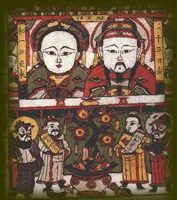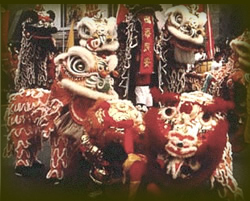 |
 |
| Kitchen
god and his wife |
Lion
dancers |
It is said that the legendary Emperor Huangdi invented the calendar in 2637 BCE, when he introduced the first cycle of the zodiac. Years in the Chinese calendar are marked not only by number* but are also allocated to one of 12 animals. The story goes that, before he departed from this life, the Buddha summoned all the creatures in his kingdom. Only twelve came to bid him farewell—the rat, ox, tiger, hare, dragon, serpent, horse, sheep, monkey, rooster, dog, and pig—each of whom was rewarded by having a year named after them.
The Chinese calendar is based on a combination of lunar and solar movements. The year begins with the first new moon of the lunar cycle, the extended festivities lasting until the Lantern Festival (Teng Chieh), which occurs 15 days later at the time of the full moon.
Preparations for New Year—also known as the Spring Festival (Yuan Tan)—actually begin on the 23rd day of the last lunar month, with a ritual known as “sending off the kitchen god.” This is the deity who protects the home and audits the family’s behaviour. Each year he is recalled to heaven; after offering him a sticky cake—said to both sweeten his mood and make it difficult for him to speak (in case he was thinking of giving them a bad report)—the family set his image alight, thus sending him on his way.
Yuan Tan is celebrated as a time of reunion and thanksgiving. Houses are cleaned, debts are paid, new clothes are bought and every effort is made to remove all traces of ill fortune lingering from the previous year. The entrance to the home is decorated with calligraphic banners (chun lian, “spring couplets”), hopeful messages intended to elicit good fortune. A feast called “surrounding the stove” is held on New Year’s Eve, when the spirits of the ancestors join the living round the family banquet table. Parents encourage their children to stay awake as long as possible in the belief that battling sleep will increase their parents’ longevity.
At midnight, firecrackers are set off and lion-dancers reenact the story of Nian, a mythic beast who appeared in the days of Huangdi to terrorise the countryside. This creature was so fierce that only a lion was able to drive it off. The next year, when the beast returned to take his revenge, the people created a lion out of bamboo and cloth; two men crawled inside and, prancing and roaring, once again managed to banish the beast. From that moment onward, lion dances became a vital part of the New Year tradition.